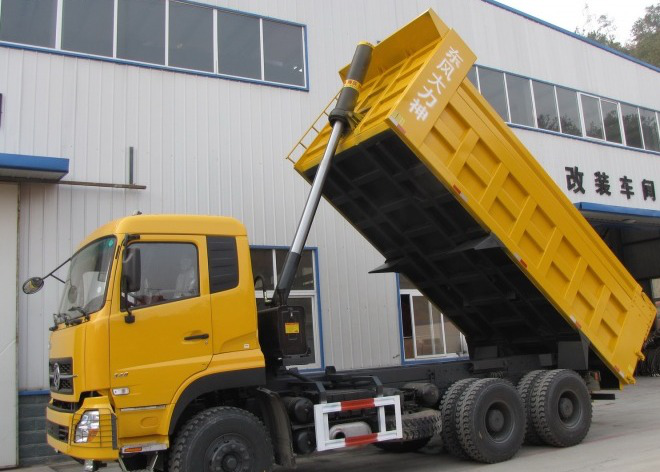Phenomenon 1: the cylinder pulling position is directly behind the cylinder barrel
Phenomenon 2: the cylinder pulling position is on both sides of the cylinder barrel
What is the best dump semi trailer?
Fault analysis for phenomenon 1:
Usually, the second or third cylinder of the oil cylinder (pull the cylinder according to the vehicle type and oil cylinder type) collides with the lower corner of the front plate of the carriage after lifting a certain height, resulting in cylinder pulling. The reason is due to the design and installation problems of the loading plant.
Fault analysis for phenomenon 2:
The cylinder pulling part is on both sides of the cylinder barrel. The main reasons are as follows
1. Deflection lifting:
A.the ground of unloading site is uneven
There are two common faults of cylinder pulling
Phenomenon 1: the cylinder pulling position is directly behind the cylinder barrel
Phenomenon 2: the cylinder pulling position is on both sides of the cylinder barrel
Fault analysis:
Fault analysis for phenomenon 1:
Usually, the second or third cylinder of the oil cylinder (pull the cylinder according to the vehicle type and oil cylinder type) collides with the lower corner of the front plate of the carriage after lifting a certain height, resulting in cylinder pulling. The reason is due to the design and installation problems of the loading plant.

Fault analysis for phenomenon 2:
The cylinder pulling part is on both sides of the cylinder barrel. The main reasons are as follows
1. Deflection lifting:
A. the ground of unloading site is uneven
B. partial load of goods.
B.poor liquidity of goods. Block goods (such as stones, coal, etc.) have good fluidity and can be unloaded in a short time. The fluidity of powdery goods or goods with high viscosity is poor (such as pulverized coal, iron powder, wet soil, etc.). In the process of lifting, half of the goods will be unloaded and the other half will not be unloaded. At this time, the oil cylinder is lifted while the carriage is tilted, resulting in the tilted lifting.
2. Drop the box and drive at the same time:
After unloading, the vehicle left without lowering the oil cylinder to the bottom. Because the road surface is not smooth, the carriage is shaking violently when the vehicle is driving. At this time, the cylinder is easy to pull when the vehicle is walking and falling back. This situation is a serious violation of operational norms.
3. The big nut at the top of the oil cylinder is loose
Users should check regularly.
Inspection of fault phenomenon:
Check for phenomenon 1:
Check whether there are traces of cylinder pulling at the back of the cylinder barrel. If there are, it can be said that the cylinder will rub with the lower corner of the front plate of the carriage after lifting a certain height, resulting in cylinder pulling.
Check for phenomenon 2:
1. Check whether the main beam, auxiliary beam and carriage are deformed.
2. Check whether there is deviation in the installation of oil cylinder.
3. Check whether there are any scratch marks on both sides of the base cylinder and the outer sleeve. If there is, it means that the car is tilted and lifted. Because in the case of no problem in vehicle and installation, the outer sleeve will not touch the base barrel during normal lifting. (not only the base cylinder is seriously scratched, but also the cylinder is seriously scratched, which is a serious case.)
4.Check whether there is any impact mark of outer sleeve on the slope surface of base cylinder anti-collision ring. If there is, it means that the car is moving while it is dropping. Because when there is no problem with the vehicle and installation, the outer sleeve mouth is in the shape of a bell. When it falls back normally, it will not hit the slope surface of the anti-collision ring, but will only friction with the vertical surface of the anti-collision ring. (not only the anti-collision ring but also the base cylinder are seriously scratched, which is a serious case.)
Treatment measures:
When dealing with the oil leakage (cylinder pulling) fault, we must patiently explain the real cause of the oil leakage (cylinder pulling) to the user. Sometimes, out of the mentality of compromising with the user, they go to repair without explanation. The user will not pay attention to correct the wrong operation, and similar failures will occur repeatedly. In this way, the real significance of maintenance is lost, resulting in vicious cycle
Post time: Mar-15-2021
